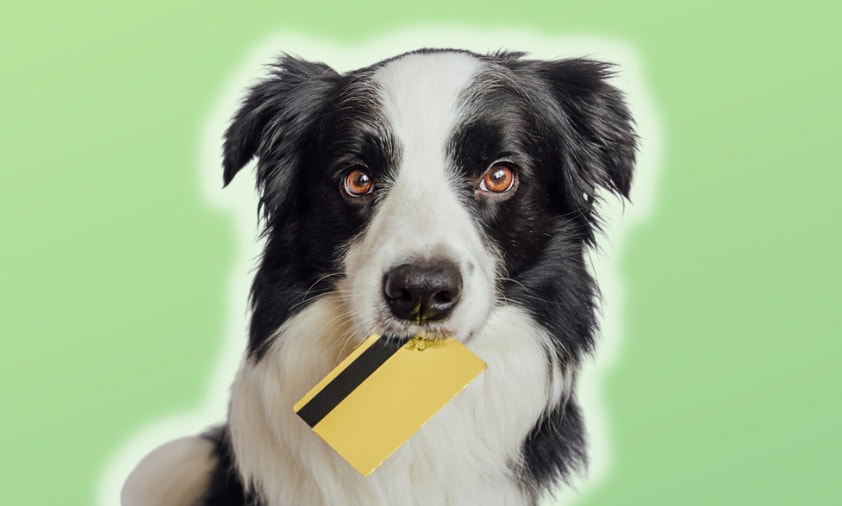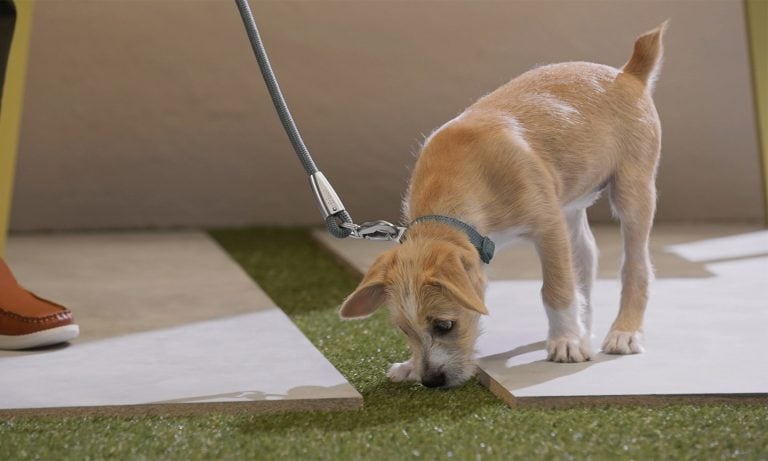Loving your furry BFF don’t cost a thing. But owning a dog sure does—potentially to the tune of $25,000.
Seem like a lot? Let us break it down for you. The average yearly cost to have a dog is about $1,900, and the average dog lives 10-13 years. But remember, that’s just the average. Both the annual cost and lifespan can vary based on the size and breed of the dog.
Bottom line: A dog is a significant expense, and you’ll want to make sure you can afford to keep them happy and healthy all their days. After all, they so deserve it. (And having a budget for your new dog is part of being a responsible pet parent.) Here’s a look at all the costs involved to help you plan.
Initial Investment
Bringing a dog into your life involves some larger expenses up front. Let’s go over some of the initial costs you should expect to cover.
Adoption Fee
If you adopt a dog from a shelter or rescue, the organization will charge a fee to help cover some of the costs associated with holding the animal and getting them ready for adoption. Those costs often include spay or neuter surgery, microchipping and vaccines. Learn more about what’s included in adoption fees.
Adoption fees can range considerably; some purebred or less common breeds might have higher demand, which translates to higher fees. The same is true of older or special needs dogs that require more medical care prior to adoption.
Typically, adoption fees can be anywhere from $35 to $350, or even more, according to Julie Castle, CEO of Best Friends Animal Society.
Breeder Purchase Fee
Millions of adoptable dogs end up in U.S. shelters each year, but if you choose to buy a dog from a reputable breeder, the costs can vary more widely, from the high hundreds to several thousand dollars, according to Dr. Jerry Klein, DVM, chief veterinary officer for the American Kennel Club. Again, the breed and its popularity will have a big impact, though buying a dog from a breeder is usually much more expensive than adoption. “Sometimes they charge thousands of dollars for them, because there's just a market for them,” he explains.
For instance, a breeder may charge $875 for a Beagle puppy, while an English Bulldog costs upwards of $3,800, on average. However, that fee should include certain benefits, including documentation of their pedigree, certification of good health, and an even temperament that’s matched to the family.
While many breeders really care about the puppies they sell, buyers should beware of “puppy mills,” which are run by unscrupulous breeders uninterested in the health or welfare of the animals. “These puppies suffer from a wide variety of physical and behavioral challenges,” Castle explains. “This is both inhumane and, since we’re talking about cost, could wind up costing you a tremendous amount of money in vet and training bills.”
As responsible pet parent, it really is on you to always do your homework to ensure you are purchasing from a reputable breeder. Find AKC breeders in your area.
Vet Costs
Some medical expenses might be covered by the organization you buy or adopt from, as noted above. It’s fairly common to have spay/neuter surgery and vaccines taken care of before the dog is available, which are rolled into the adoption fee.
However, depending on the age of the dog, you may still need to follow up with additional wellness exams, shots, and more within the first few months. “The first year of life is probably going to be the most expensive,” Dr. Klein says. That’s because you’re providing your new fur baby with the veterinary care they’ll need to grow into happy, healthy adults. This initial investment helps set them up for future success.
In fact, a puppy requires around $700 to $2,000 in veterinary care during their first year, according to Dr. Klein. Adult dogs, on the other hand, might only require routine annual care (more on that later).
Supplies
It’s time for the fun part: Shopping! Preparing for your new dog to come home means stocking up on all the products necessary to give them the very best care (plus some fun extras, too). Items on your shopping list will probably include:
- Dog food and treats. (See Chewy customers' favorite dog foods.)
- Food and water bowls
- Collar and ID tag
- Leash
- Poop scoop and pet waste bags
- Dog crate. (See Chewy customers' favorite dog crates.)
- Dog bed and blankets
- Toys
- Grooming products, such as shampoo, brush and nail trimmers
- Training tools, such as a dog clicker
- Medications and supplements, such as flea prevention and calming chews
- Cleaning supplies for messes (because they’re going to happen!)
Get a full list of supplies for dogs of every life stage.
In general, you can expect to spend a few hundred dollars to get your dog set up. Again, the cost of these start-up supplies can vary quite a bit, depending on the brand and where you buy them. For example, Chewy offers 35% off for all first-time Autoship customers.
Microchip
Many animal shelters will microchip pets upon addition. If your dog has not been microchipped, you should talk to the vet about having it done. (The procedure involves inserting under your pup’s skin a little chip that houses your contact information).
Sadly, more than 10 million dogs and cats are lost or stolen in the U.S. every year. Even sadder? Only about 15% of dogs in shelters without microchips or ID tags are reunited with their owners.
Microchipping is an easy way to prevent such a tragedy. It typically costs $50 to $75 to have the microchip inserted and registered. Some microchip companies offer annual memberships that include additional recovery services for around $20 a year.
Training
Once your new dog is home, watch and observe how they are acclimating. Whether you’re bringing home a new puppy who needs to learn basic commands, or an older, shy shelter dog who needs help feeling calm and confident around others, a professional trainer may be in order.
The cost of hiring a dog trainer depends on their experience, location and the type of training required. It also makes a difference whether you attend group training classes or hire someone to work with your pup one-on-one.
In general, dog training classes cost between $30 and $80 per session, while private sessions cost an average of $140 per session. The average puppy training class is 4-6 weeks long (one class per week).
Common Costs of Bringing Home a New Dog
Adoption fee
$35-$350
Breeder fee
$800-$4,000
Veterinary costs
$700-$2,000
Start-up pet supplies
$300
Microchip
$50-$75
Training
$180-$480 ($30-$140 per session at 6 sessions on average)
TOTAL:
$1,265-$7,215
Ongoing Yearly Costs
In addition to the initial investment of bringing a dog into your family, there are also regular expenses you can expect to pay every year. These can cost an average of $1,937, although they will vary based on your dog’s size and breed.
Let’s take a closer look at some of the common annual expenses you should plan for when getting a dog.
Food
It’s important to feed your dog a healthy diet, so that means investing in high-quality dog food and treats. Food costs can range anywhere from $75 per year for a small dog to $300 per year for a large dog, says Dr. Klein. Certain premium brands, types of freshly made food or special vet-prescribed diets can cost even more, well over $3,000 for the year (again depending on the brand and the size of the dog).
Vet Visits
Staying up to date on routine veterinary care will ensure your dog lives a long and healthy life. “Just like with humans, preventative care like having annual checkups cost a lot less than treating an illness,” Castle says.
That means you should plan to pay for routine wellness checkups once or twice a year, which may involve lab tests, X-rays, vaccines and more.
Routine vet visits could cost between $50-$250 a year, depending on the clinic, type of dog, and where you live, according to Dr. Klein. That doesn’t factor in additional expenses related to emergencies or medications your vet may prescribe. Dr. Klein also notes that the bigger the dog, the more you’ll need to spend in this area, too, since higher doses of certain medications are needed for bigger animals.
Pet Insurance
Like healthcare for humans, veterinary care can be quite expensive. Between preventative exams, medications, visits for illnesses or injuries, etc., you could end up shelling out thousands.
That’s why buying pet insurance can be a good idea, especially if you have a breed that’s prone to health issues. There are many options available with different levels of care included, from basic wellness plans for check-ups and preventative care, to more robust (and expensive) plans. For example, Chewy’s CarePlus wellness plans start at $20 per month, while insurance plans for combined accident and illness coverage range between $35 and $120 per month.
Learn more about pet insurance and what plans typically cover.
Toys and Accessories
Keeping your pup comfy and entertained should absolutely be a priority. Providing proper enrichment can help keep behavior problems at bay—a bored dog will find their own form of entertainment. But this is one area where you have a lot of flexibility in how much you spend.
“You can go crazy with pet accessories these days,” Castle says. “From outfits, to fancy bowls, to elaborate dog houses and beds—you name it, it’s out there. But none of these are necessities.”
It’s up to you to set a reasonable budget for these types of items. The average person, however, can expect to spend around $100 per year.
Shop these dog parent-tested and approved dog toys.
Grooming
Dogs need grooming as a part of basic health maintenance, and the level of grooming they need depends on the breed.
For breeds with shorthair, “it can be a simple bath … so all you’re looking at is the cost of dog shampoo,” Castle says. Pet shampoo can cost around $20.
For longer-coated dogs, such as Poodles or Afghan Hounds, grooming can be a lot more complicated.
“Keeping fur out of their eyes (and out of the other end) and keeping them free from matts and tangles—which can be really uncomfortable—is important,” Castle says.
On the high end, you could shell out up to $1,400 per year on frequent trips to a professional groomer.
License
In addition to a microchip and pet tag, it’s important (and often legally required) to register your dog with your city and obtain a license that they wear. If your pup gets loose, a dog license proves that they’re vaccinated and makes it easier to track you down. Plus, the fees—which run about $20 a year—often go toward supporting local animal control and shelters.
Miscellaneous
The ASPCA estimates that other miscellaneous costs, such as extra cleaning supplies for pet messes or doggy waste bags, average $35 for small dogs, $45 for medium dogs, and $65 for large dogs annually.
Average Annual Costs of Owning a Dog
Food
$75-$300
Vet visits
$50-$250
Pet insurance
$240-$1,200
Toys and accessories
$100+
Grooming
$20-$1,400
License
$20
Miscellaneous
$35-$65
TOTAL:
$540-$3,335
Other Expenses to Keep in Mind
Dog Sitter and Boarding
If you like to travel, there may be times when you want to go out of town, but don’t have a friend or family member to watch your pet. In that case, you’ll either need to board your dog or hire a pet sitter to stay in your home and take care of them. Boarding costs an average of $40 per night, with rates ranging from $25 to $85, according to HomeGuide. Luxury overnight hotels charge $75 a night and up. Hourly pet sitter rates may range from $12 to $17 per hour, according to Care.com.
At the very least, you might need someone to stop by once in a while when you’re busy at the office and take Fido out for a potty break. Dog walkers charge an average of $20 per 30-minute walk.
Emergencies
Even if you have pet insurance, it’s possible for your dog to end up with an illness or injury that requires extensive care that isn’t fully covered. For that reason, it’s important to start an emergency fund and put money aside every month.
Personal finance website FinanceBuzz looked at the most common dog surgeries and the average costs of performing them:
- ACL and CCL surgery: $1,000 to $3,000 per knee
- Cataract surgery: $2,600 to $4,000
- Herniated disc: $1,500 to $4,000
- Hip replacement: $3,500 to $7,000 per hip
- Intestinal blockage surgery: Up to $7,000
- Stomach flip surgery: $1,500 to $7,500.
As you can see, emergency vet bills for a dog can be just as pricey as for humans, so it pays to be prepared and have extra funds set aside just in case.
Senior Care
As dogs reach their senior years, there tend to be more costs associated with specialized care. “If you find that your dog does have to go to a specialist—for example, it has a cataract or a heart murmur—the cost of seeing specialty veterinarians can be very expensive,” says Dr. Klein.
Specialized care senior dogs may require (and their estimated costs*) include:
- Cataract Surgery: $2,700-$4,000
- Abdominal ultrasound: $350-$1,000 per visit
- ACL repair: $1,500-$4,000
- Tumor removal: $100s-$1,000s
- Radiation therapy: $2,000-$6,000
- Dental cleaning: $170-$4,000
- Chemotherapy: $200-$6,000 but could reach up to $30K. Treatment typically runs 3-6 months, and additional costs usually include repeat bloodwork prior to treatment to verify that chemo is safe to administer at each visit, antinausea medications, etc.
- Cardiac consultation/echocardiogram: $200-$800 per visit. For most dogs under the care of veterinary cardiologist, this type of testing may need to be repeated 2-3 times per year, but initial consult fees should only apply to the first visit.
- Bloodwork: $100-$250 per visit. Most geriatric patients on chronic medication should be getting repeat bloodwork done 2-3 times yearly depending on the underlying medical condition(s) being treated.
*Note: Costs vary depending on factors such as severity of condition, whether a general practitioner or a specialist is providing the care, practice location, size of dog, etc.
Once your dog reaches senior status, it’s important for them to see a vet twice a year since there’s a higher chance of developing health issues. By seeing a vet early and often, and performing preventive measures like blood analysis and X-rays, you can more easily catch and treat problems such as arthritis, digestive issues and weight gain.
You might also need to buy special equipment to help senior dogs get around easier. For instance, stairs or a ramp can help an older dog get onto the couch or into the car without having to jump. They might also require special toys for sensitive teeth, or doggy diapers if they’re incontinent.
Learn more about caring for senior dogs.
End of Life Care
Of course, there’s the one part of owning a dog that everyone hates: saying goodbye. But as a dog mom or dad, it’s your duty to continue providing your fur baby the same level of care and attention up until their last breath.
Some people experience sticker shock on top of an already emotionally draining process. So it’s helpful to know how much euthanasia can cost, depending on how you go about it. Here’s how much you can expect to spend for the service at the vet’s office, on average, according to PetMD:
- Independent vet offices: $50-$100
- Large chain vet hospitals: $58
- Emergency vet hospitals: $100-$200
Alternatively, some people choose to have the process take place in their home, where the family can be with their pet in the lowest-stress environment possible. If you go this route, you may pay $100-$200, plus up to another $100 in additional travel fees, depending on the distance.
There is also the pet’s aftercare to think about. You might choose a private cremation, which starts at $100 for small pets. Larger animals, specialty urns, or other add-ons can increase the costs. Opting for a communal cremation saves a bit of money, and starts at $50. If you decide you want your beloved family dog buried in a cemetery, expect to spend $500-$700.
Pop Quiz
Click or tap the cards to see the answers.
$1,9371
False
Expenses vary based on size and breed.
False
Pet insurance can save you thousands of dollars on preventive and emergency care.
If you’re looking to make a new pooch part of your family, don’t be daunted by these numbers. But do consider them carefully.
“Before you get a dog, make sure you can afford it,” Dr. Klein says. “You want to make sure you make a commitment for the life of that animal.”
With a solid pet budget and some planning, you can make the costs of owning a dog work. Just be sure to consider factors such as the breed, age, size and activity level of a potential pup before making a decision as these can greatly impact the expense. And remember that regular veterinary care and pet insurance can keep your dog’s lifetime health costs down.
More money topics to explore:
Share:


















